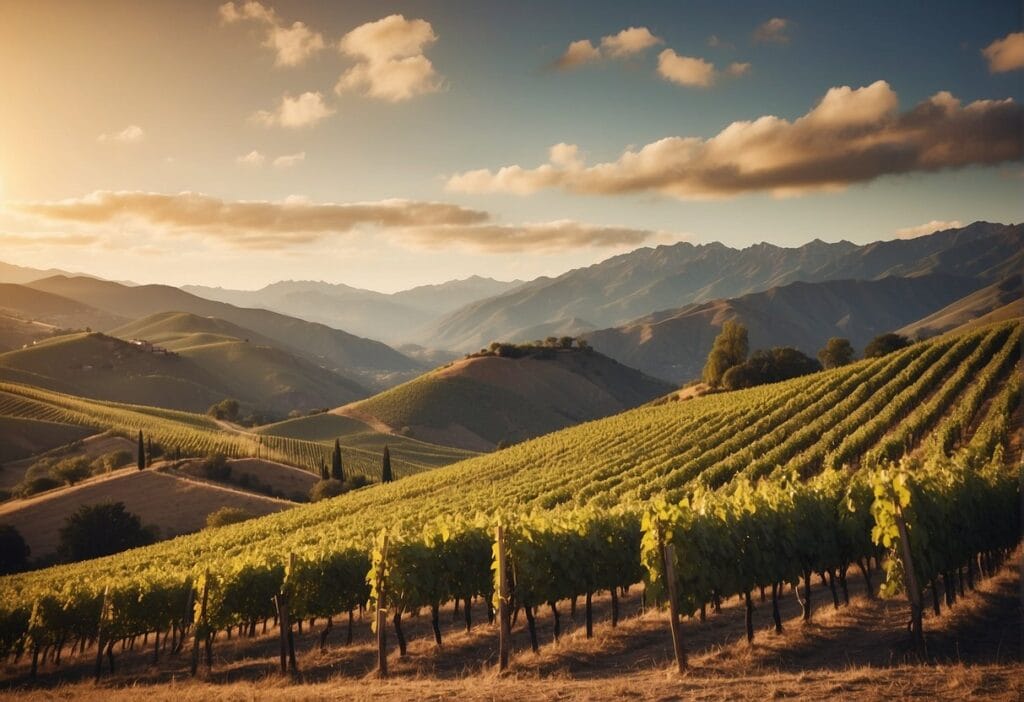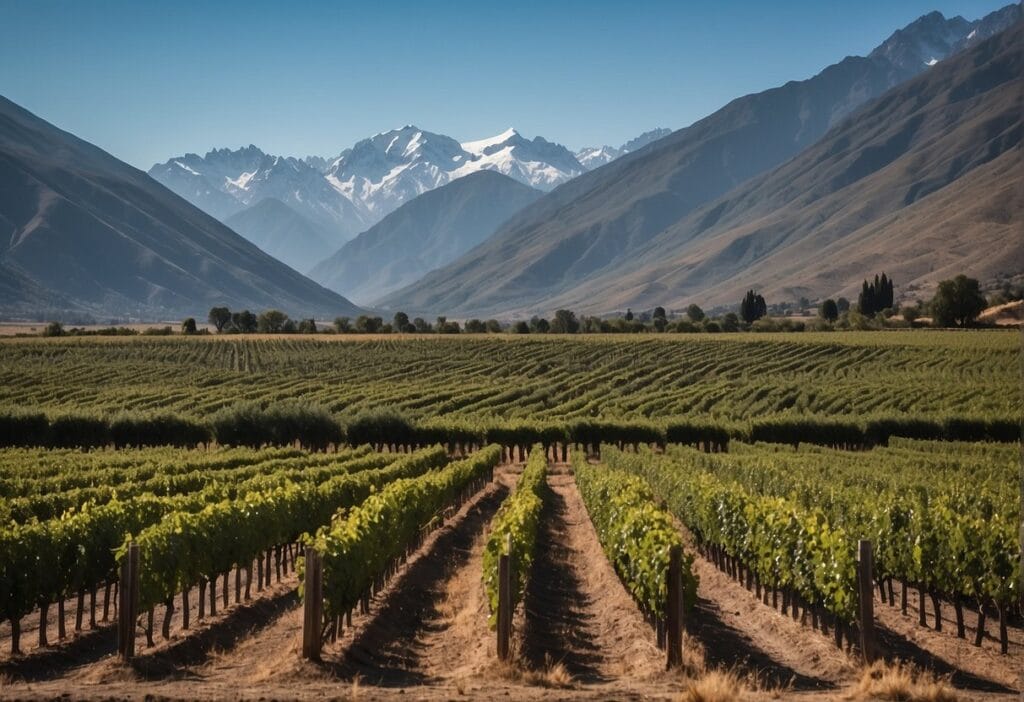Nestled in the southern end of Chile, the Itata Valley is a treasure trove of viniculture with a legacy reaching back to the dawn of Chilean wine history. Your journey into the world of wines would be incomplete without exploring this cool-climate region, which is revered for its artisanal winemaking traditions and ancient vineyards.
The Itata Valley beckons with its variety of vines such as Carignan, Muscat of Alexandria, and the indigenous Pais, although there’s a growing presence of international varieties like Cabernet Sauvignon and Pinot Noir.
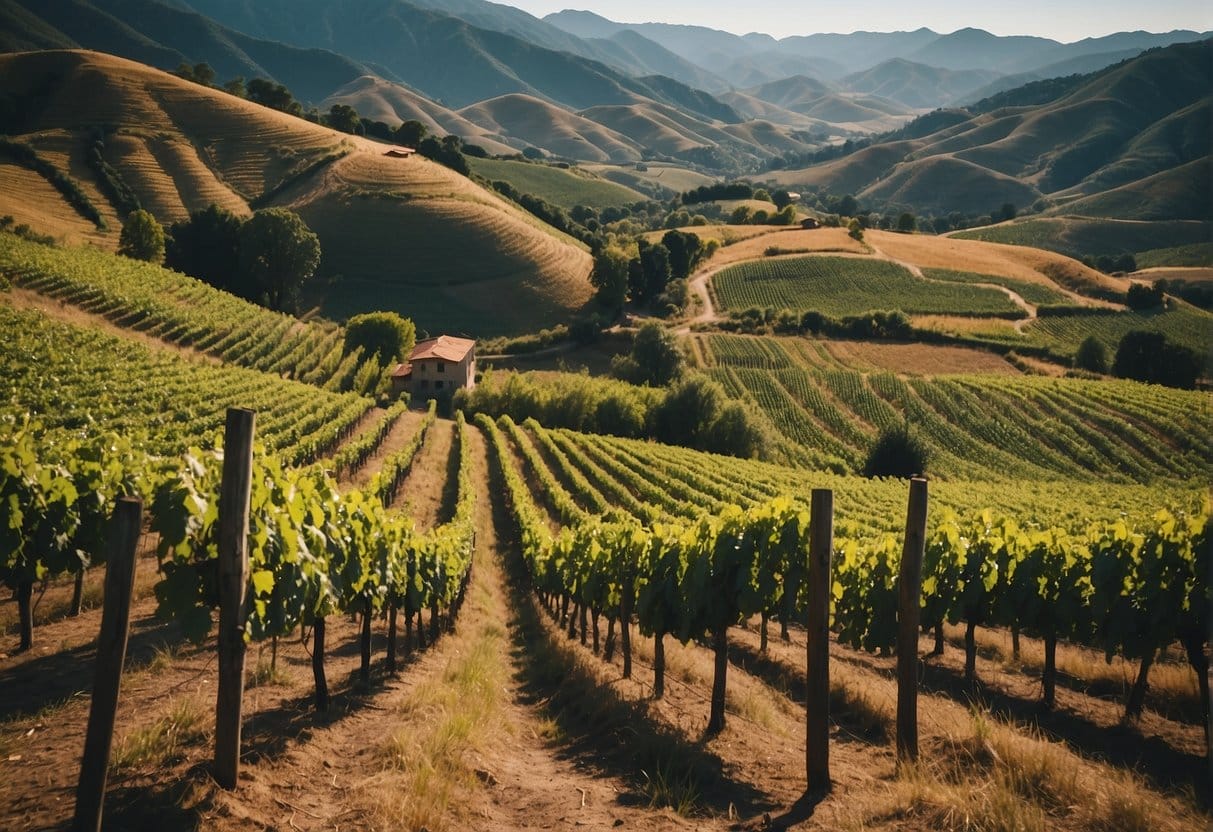
As you venture into the heart of Itata, you’ll appreciate how the diverse geography from coastal influences to river valleys shapes the character of its wines. The deep understanding of viticulture paired with the evolving winemaking styles lends each bottle from Itata a unique story.
Beyond just producing wine, this region reflects a rich tapestry of cultural significance, where each bottle speaks to the area’s heritage, and each vineyard visit offers a glimpse into Chile’s enological narrative.
Key Takeaways
- Itata Valley is a historic, cool-climate region in Chile, producing diverse wines.
- The area’s unique geography and age-old vines contribute to distinctive wine profiles.
- Itata Valley’s wines encapsulate the rich cultural and viticultural heritage of Chile.
History and Origin
When you explore the Itata Valley, you’re delving into one of Chile’s oldest and historically rich wine regions. This region is where Pais and Moscatel, also known as Muscat of Alexandria, first set root in the Chilean soil.
Early History
The early history of Itata is closely intertwined with the arrival of Spanish conquistadors and missionaries. As early as 1551, these missionaries planted the first vines in the region. The initial varietals included Pais and Moscatel, which were transported from the Canary Islands to Latin America. The Itata Valley soon became one of the foremost centers for Chilean viticulture, with these grape varieties flourishing in the valley’s conducive climate and terroir.
Modern Development
In more recent years, after experiencing a decline, there has been a resurgence in Itata as a prominent wine region. This modern development highlights the rediscovery of old vineyard sites where Pais and Moscatel de Alejandría stand out for their contribution to the region’s distinctive wines.
Local winemakers are now championing these varieties, often focusing on natural or low-intervention winemaking practices that respect the deep-rooted vinicultural heritage. It’s through this blend of tradition and innovation that Itata’s wine scene is currently experiencing a renaissance, once again capturing the interest of wine connoisseurs worldwide.
Geographical Characteristics
Exploring the Itata Valley will uncover its unique geographic traits, shaped by its position, unquestionably influencing the distinct wines you’ll discover here.
Location and Terrain
Itata Valley is nestled in the southern reach of Chile, where the Ñuble Rivers weave through the landscape leading toward the Pacific Ocean. This valley, framed by the majestic Andes to the east and the Coastal Range to the west, boasts a terrain that’s as rich as it is diverse.
You’ll find a spectrum of soils here, predominantly comprised of alluvial compositions that nurture the vineyards. It encompasses towns like Coelemu and Quillón, and extends southward to Chillán, situating it in the heart of Southern Chile’s winemaking heritage.
Climate Influences
The wines of Itata Valley are profoundly influenced by its climate, which is notably cool due to both its latitude and proximity to the ocean. The valley benefits from the cooling effects of the Humboldt Current, creating ideal conditions for a range of grape varieties to thrive.
The combination of river breezes and coastal influence bestows Itata Valley with its unique terroir, which is a significant driver behind the character and quality of its wines. This dynamic mix of elements results in wines with remarkable complexity and freshness that have come to define the essence of this charming region.
Viticulture
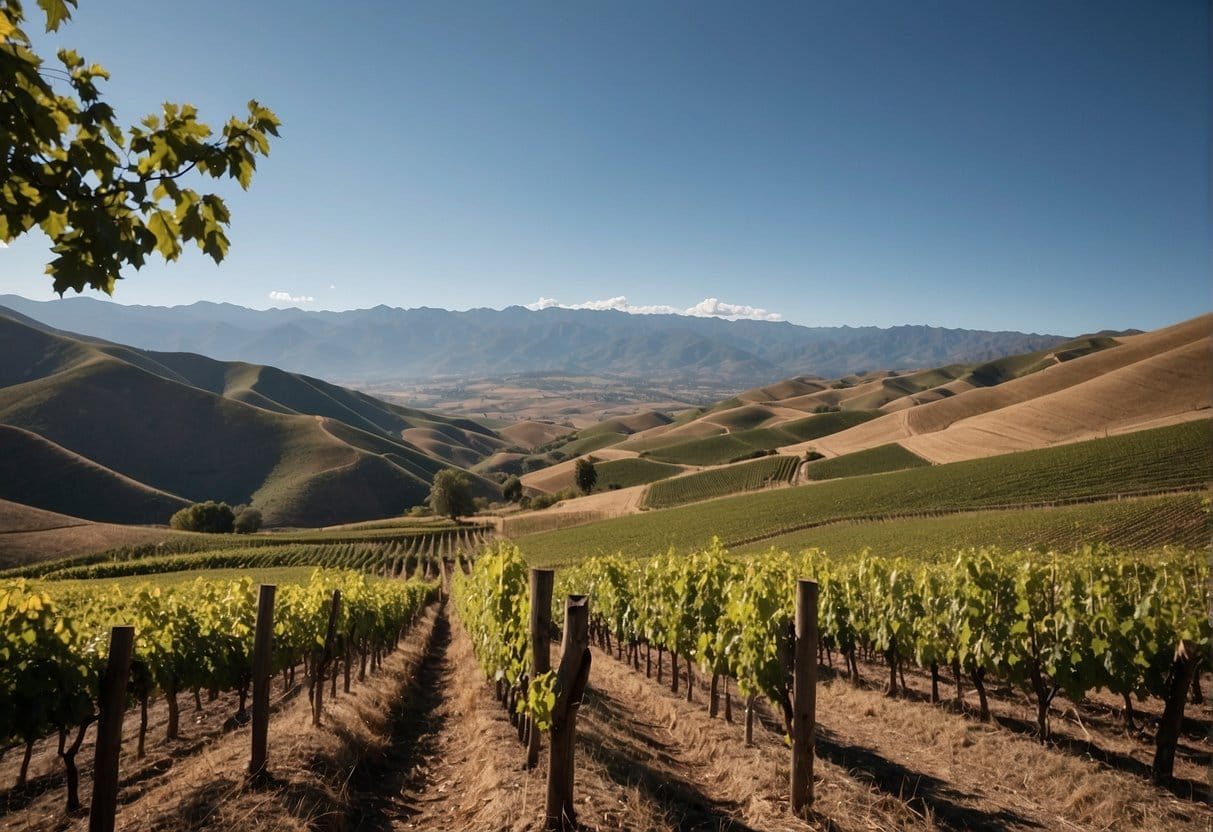
As you explore Itata Valley’s wine region, you’ll find a blend of traditional and modern viticulture practices tailored to its unique terroir.
Grape Varieties
The Itata Valley is revered for its varied grape varieties, which include historical strains like País and Muscat of Alexandria, as well as a more recent focus on Cabernet Sauvignon, Cinsault, and Carignan. Notably, Itata has been instrumental in reviving interest in Carignan, producing wines with depth and character.
Meanwhile, internationally recognized varieties such as Pinot Noir and Chardonnay are gaining a foothold, offering you a complexity that reflects the region’s climatic versatility. Among these, you can enjoy the crisp and aromatic offerings from the Muscat, or taste the legacy of the region with a glass of rich, red País.
Vineyard Practices
The viticultural methods in Itata reflect a deep respect for the land. Vineyards here often boast alluvial soils that vine roots deeply penetrate, drawing nutrients to produce high-quality grapes. Many vineyards are dry-farmed, which means they rely solely on nature’s bounty of rain. This practice highlights the region’s commitment to sustainability and traditional farming methods.
Irrigation is less common, but when it’s used, drip irrigation is the preferred modern technique to conserve water and focus on the health of the vines. Winegrowers here skillfully balance moisture levels to ensure the vines thrive.
Vine density varies, with newer plantings typically being more dense, which can lead to higher quality wines due to competition between vines. In Itata, you’ll find that the wine reflects both the rich history of winemaking and the innovative approaches that yield distinctively flavorful wines.
Winemaking Styles

In the Itata Valley, your encounter with winemaking styles will be a journey through time-honored traditions and the embrace of new winemaking innovations. Discover how each method contributes to the region’s unique wine offerings.
Traditional Methods
Itata Valley’s winemaking roots reach deep, with some vineyards dating back over 150 years. The traditional Pipeño, a simple, rustic wine, is a nod to the local history. It’s typically made from the País grape and reflects the essence of the region’s ancestral methods.
The vineyards often employ dry-farming techniques, and you’ll notice a reliance on old bush vines that are naturally low in vigor, yielding grapes with concentrated flavors. The use of open fermenters and manual labor continues to be prevalent, ensuring each bottle is imbued with the region’s character.
Innovation and Techniques
While the Itata Valley respects its winemaking heritage, forward-thinking winemakers are introducing exciting new processes. You’ll find a natural progression towards orange wine, produced by leaving white grape skins in contact with the juice for extended periods. This old method, which has found new life here, lends unique complexity and tannic structure to the wines.
Additionally, innovative sparkling wine production is gaining traction, offering you fresh, vivacious styles perfect for celebrations or a casual toast. Modern vineyards aren’t shirking away from planting internationally renowned varietals either, infusing the region’s portfolio with modernity while emphasizing the distinctive terroir.
Wine Producers and Wineries
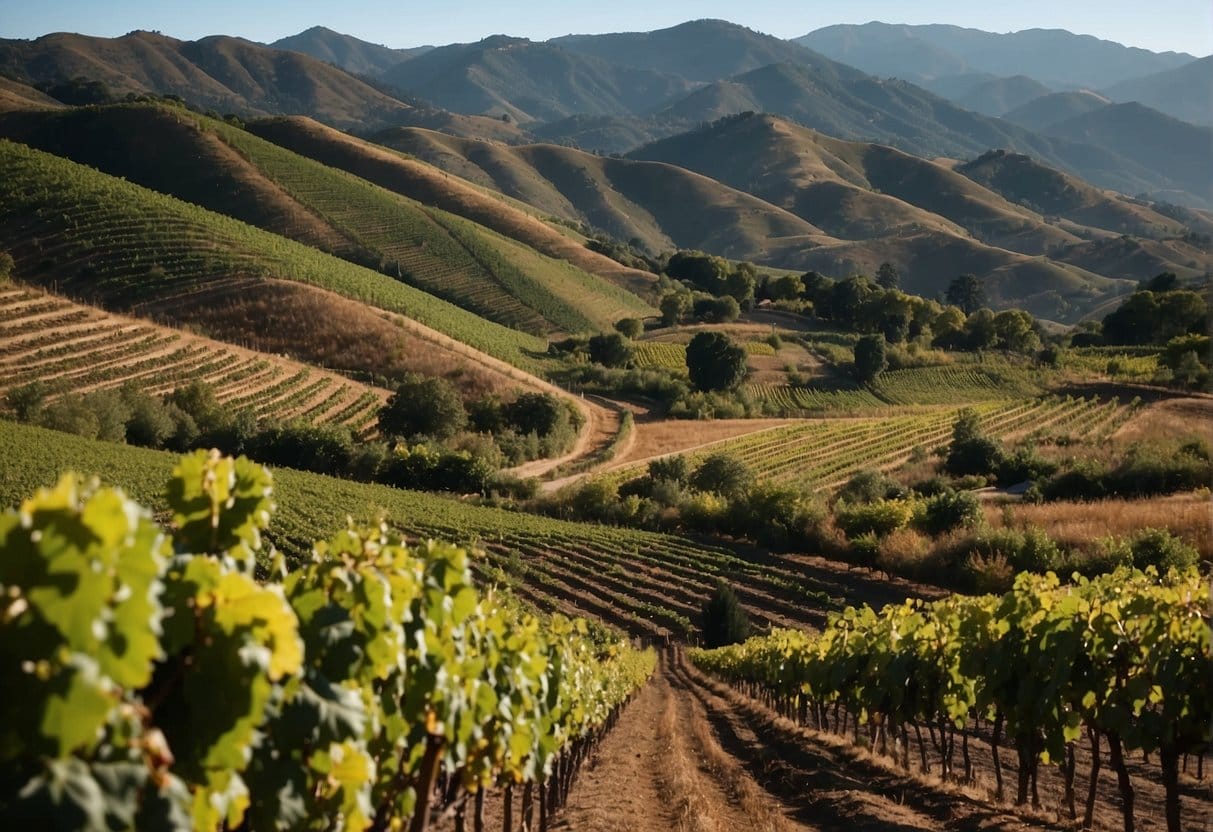
In the heart of Chile’s Ñuble Region, you’ll discover Itata Valley’s rich viticultural heritage. This area is home to some exceptional wineries, each contributing to the valley’s growing reputation for fine wine.
Notable Wineries
- De Martino: Pioneering the rebirth of Itata Valley wines, De Martino focuses on creating expressive wines that reflect the unique terroir of the region. Your wine journey might begin with their remarkable old-vine Cinsault.
- A Los Viñateros Bravos: With a commitment to reflecting Itata’s purest expression, this winery offers a range of wines that showcase the character of their vineyards, including elegant and mineral-rich Cinsault that you might find simply unforgettable.
- Carmen: As one of the oldest wineries in Chile, Carmen has a deep connection to Itata Valley, creating wines that resonate with history while embracing modern techniques to enhance the experience in your glass.
Wineries in Ñuble:
Itata Valley is part of the broader Ñuble Region, which boasts a diverse array of wineries. Your adventurous palate will be delighted by the innovative spirit and careful craftsmanship found in each bottle from this corner of the wine world.
Cultural Significance
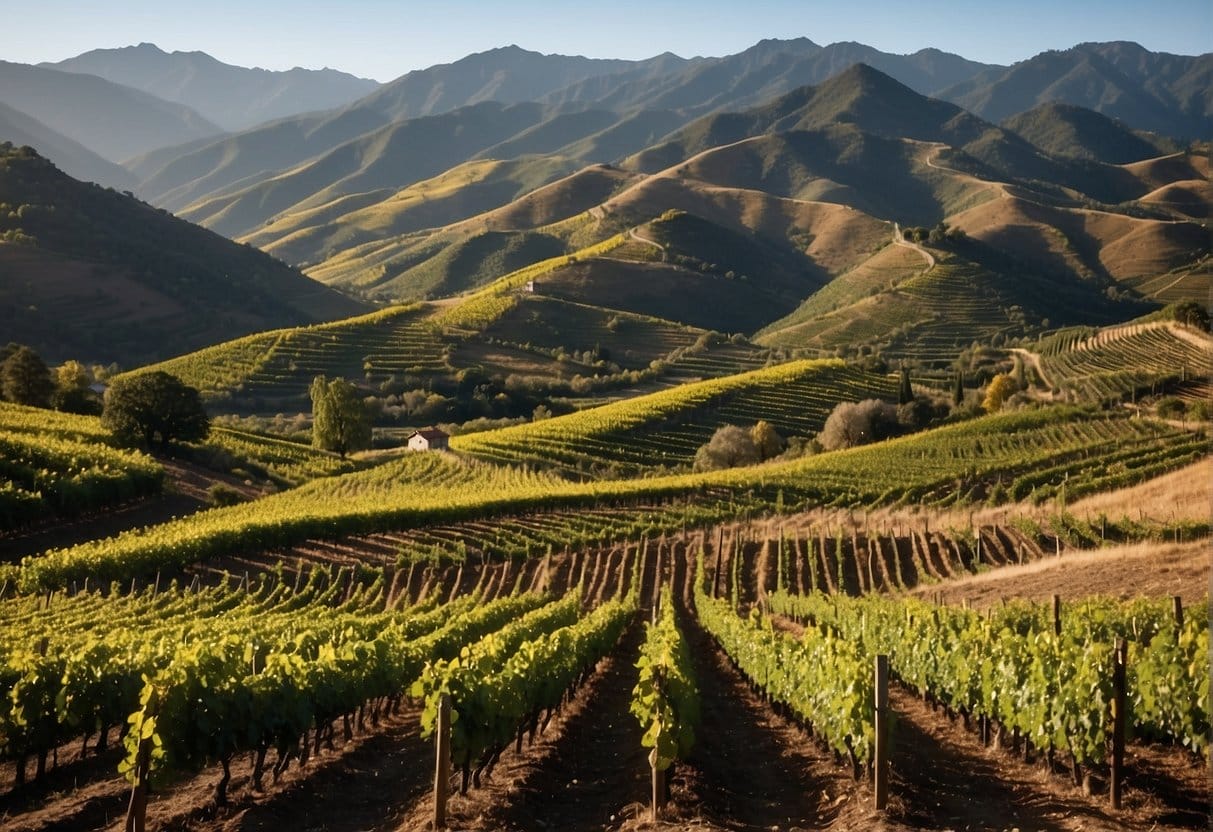
The Itata Valley is not only renowned for its exquisite wines but also for its vibrant cultural landscape, which includes a rich culinary history and a dynamic arts scene.
Culinary Traditions
In Itata Valley, you’ll discover a cornucopia of local flavors that perfectly accompany the region’s wines. Signature dishes often feature the exceptional produce from local markets in Chillán, renowned for its variety of fresh foods. You can participate in the tradition of the Chilean asado, or barbecue, an event that brings together family and friends over sumptuous meats and sides, full of the region’s rustic charm.
Music and Arts
As you explore Itata Valley, you’re likely to be captivated by the intertwining of music and winemaking, which creates a melodious backdrop to the grapevines. Notably, Claudio Arrau, an eminent pianist from Chillán, has imparted a legacy of musical excellence in the area.
Local artisans in Bulnes and surrounding locales continue to produce crafts that reflect the heritage of the Valley, such as woven baskets and pottery, often using techniques that have been passed down for generations. These items are not merely decorative but hold a functional place in the everyday life of the region’s inhabitants.
Tourism and Attractions
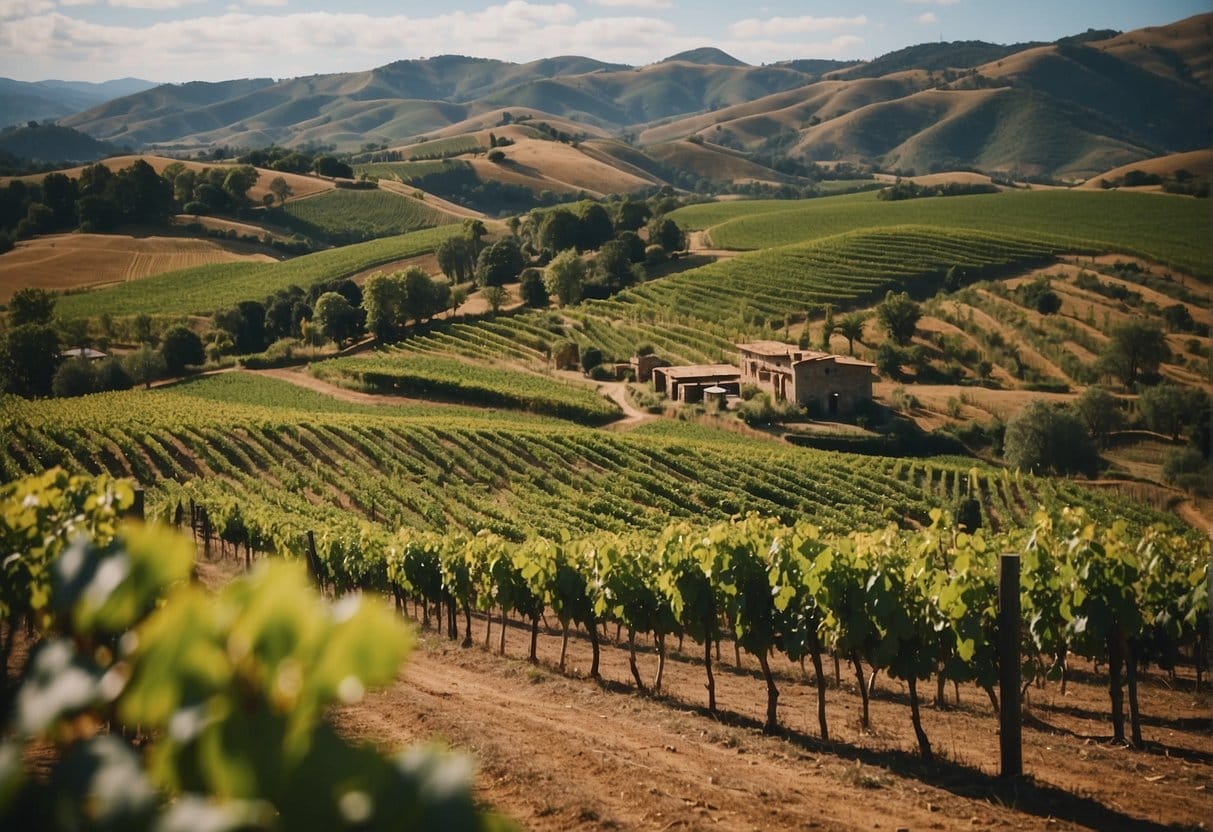
Exploring the Itata Valley wine region offers you an enchanting blend of viticulture and vibrant local culture. As you navigate through this picturesque area, you’re invited to indulge in world-class wine tours and savor the rich Chilean heritage through various landmarks and activities.
Wine Tours and Tasting
Discover the essence of Chilean wine-making with a visit to the Itata Valley. This region is renowned for its granitic soils and traditional methods that contribute to the unique flavors of its wines. A wine tour is essential for appreciating the craftsmanship behind each bottle. You’ll find various options for tastings that allow you to delve into a selection of the most-planted grape varieties, including the heritage grape País.
- Book Your Experience: Choose from numerous wineries offering guided tours and tastings. Some of the best wineries in the Itata Valley to visit can be easily booked online, ensuring your spot is secured.
Local Landmarks and Activities
Beyond the vines, the Itata Valley is dotted with fascinating landmarks. Take a day to unwind at the Termas de Chillán, a spa complex famous for its hot springs and touted as a haven for relaxation and wellness.
- Explore Concepción: Dive into the urban experience with a visit to Concepción, a city full of historical sites and a lively arts scene.
- All Aboard: Step back in time with a ride on a train that cuts through scenic landscapes, connecting you not just between locations, but also to the area’s rich history.
Your exploration of Itata Valley’s wines and wonders promises a journey full of memorable moments and breathtaking sights.
Economic Impact
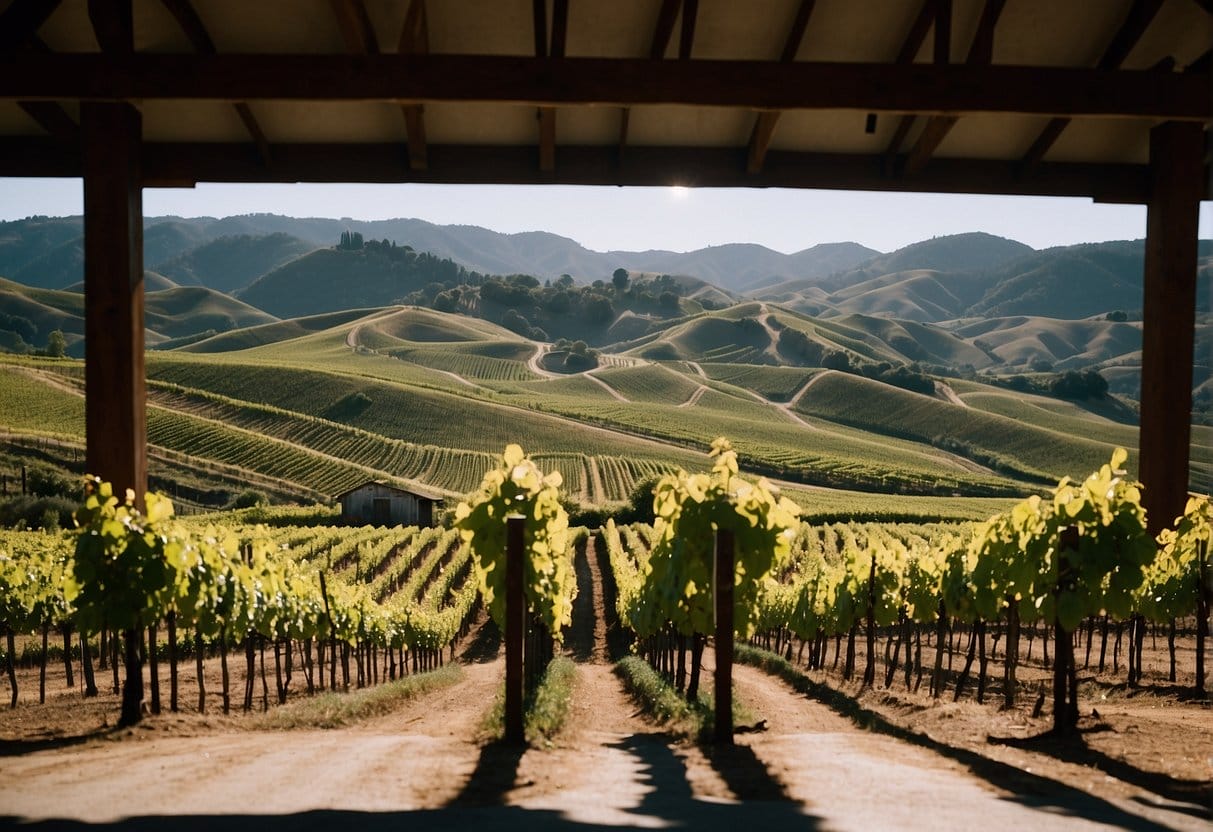
Your understanding of Itata Valley’s economic influence should begin with its role in wine exports and trades. Despite being less known than regions such as California, it holds a significant place in the Chilean wine landscape.
Wine Export and Trade
Itata Valley’s contribution to Chilean Wine exports offers distinctive flavors that distinguish it from more familiar territories like California. The wines from Itata, often crafted from traditional methods, have begun to capture the attention of international markets.
Their focus on sustainability and the use of dry farming techniques not only positions Itata wines as environmentally conscious choices but also adds a unique selling point that appeals to eco-minded consumers around the globe.
With 850 to 1,100 mm of rainfall annually, allowing for dry farming, Itata Valley stands out for needing no irrigation, which aligns well with increasingly vital sustainability efforts. Initiatives that capitalize on these sustainable practices could potentially boost trade opportunities, allowing you to enjoy Itata Valley wines while supporting eco-friendly agriculture.
- Sustainable Practices: Itata’s minimal water usage can appeal to markets with eco-conscious consumers.
- Unique Flavors: The region’s ancient vines deliver wines with complex profiles unlike those found in more commercial regions like California.
- Heritage Ripe for Marketing: Itata’s deep winemaking history provides a thematic richness leveraged in storytelling for international trade.
As Itata Valley gains more recognition, expect to see it more prominently on the world stage, contributing not just to Chile’s economy but also to the diversity of wines available to you.
Conservation and Sustainability

You’ll find that the Itata Valley is not only remarkable for its wines but also for its commitment to sustainable and conservation-oriented viticulture. The valley’s natural rainfall allows for practices that conserve water, making it a forerunner in environmentally friendly wine production in the face of Climate Change.
Environmental Practices
Itata Valley employs sustainable farming techniques which play a crucial role in conservation efforts. With an annual rainfall of 850 to 1,100 mm, the region is one of the few in the New World that doesn’t require irrigation, allowing it to be completely dry farmed.
This approach conserves water, a valuable resource that’s becoming increasingly scarce in Chile. This practice not only prepares the region for a future where water resources may be more limited, but it also enhances the sustainability reputation of Itata wines.
In response to Climate Change, the vineyards in Itata naturally adapt to the changing conditions. The wines you enjoy benefit from these sustainable practices which serve to protect the environment and maintain the balance of the unique terroir of the region, ensuring the vitality of viticulture for years to come.
Frequently Asked Questions
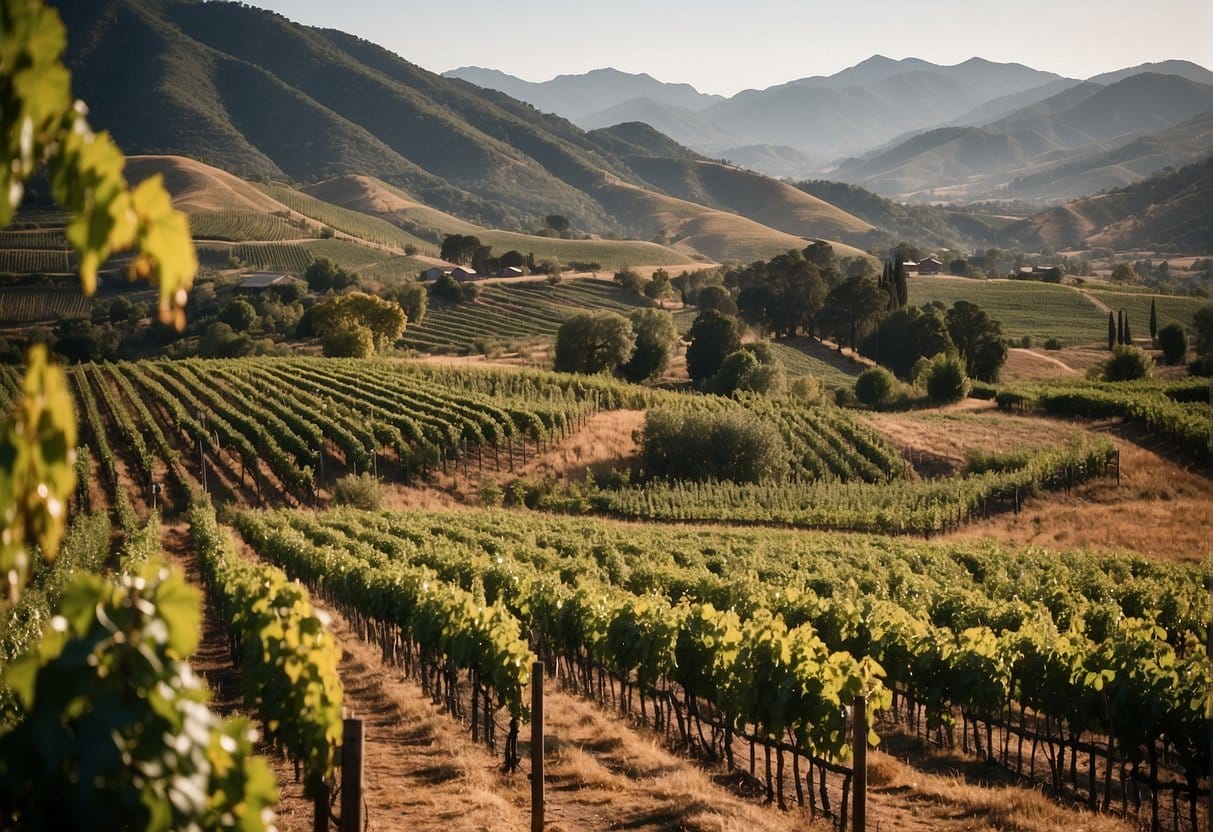
In this section, you’ll find answers to common questions about the Itata Valley wine region, from the types of wines it’s renowned for, to the unique wineries you can visit.
What types of wine is the Itata Valley region best known for?
The Itata Valley is celebrated for its old vine productions, particularly those of Pais, Muscat of Alexandria, and Carignan. This suite of grapes contributes to a range of rustic and flavorful wines cherished both locally and abroad.
Can you recommend any must-visit wineries in the Itata Valley?
Certainly! Consider exploring Viña Santa Berta for its authentic charm or delve into the boutique offerings of Vinos Mingaco. Both boast of exceptional local wines that encapsulate the spirit of Itata.
How does the Itata Valley’s terroir influence the characteristics of its wines?
The terroir of Itata Valley, with its cool climate and granitic soils, imbues its wines with vibrant acidity and complex minerality. These conditions allow for the production of wines with distinct profiles, reflecting a genuine sense of place.
What are some notable wine tours available in the Itata Valley region?
The Itata Valley offers a range of wine tours that cater to diverse tastes. Whether you’re looking to immerse yourself in the traditional techniques or sample the latest vintages, options like those offered by Viña Santa Berta are sure to enrich your wine knowledge and palate.
What are the geographical features that define the Itata Valley wine region?
Spanning roughly 100 kilometers, the Itata Valley boasts rolling hills, lush pastures, and vineyards framed by forests. This picturesque setting, nestled between the cities of San Carlos and Bulnes, is a cornerstone of its wine-making heritage.
How does the Itata Valley compare to other wine-producing regions in Chile?
While regions like the Maipo Valley are known for their Cabernet Sauvignon, Itata stands out for its focus on heritage vines and artisan winemaking. The region embraces a more traditional, hands-on approach, offering wines with a distinctive character that captures its deep-rooted viticultural history.
